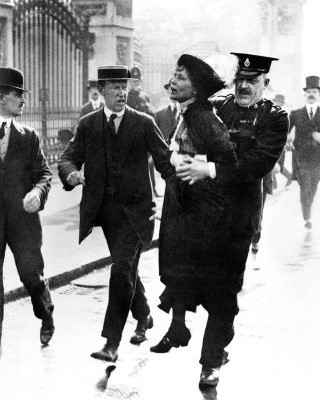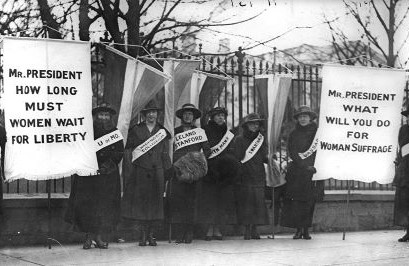The History of Women's Suffrage
Women's Suffrage
The concept of women’s suffrage dates as far back as the eighteenth century and is the idea that women should be able to vote on the same terms as men.
All over the world,
women struggled to get their leaders to allow women to participate in national elections but gradually, throughout the twentieth century, most countries came to see both the benefits and
justness of female enfranchisement.
Talk the Talk
The Nineteenth Amendment to the United States Constitution was put in place to end discrimination against women when it came to voting rights in American general elections. It reads:
"The right of citizens of the United States to vote shall not be denied or abridged by the United States or by any State on account of sex.
Congress shall have power to enforce this article by appropriate legislation."
In the earliest democracies of ancient Greece and the Roman Republic, women were barred from voting and when democratic societies reemerged in the early modern period in the West, this exclusion persisted. Men from poorer backgrounds were also disenfranchised but women increasingly came to believe that they should at least be granted the vote on the same terms as men.
Women gained the right to vote at various times all over the world and in many places, they could vote in local elections long before they could become a part of the national electorate. In the nineteenth century, the issue was particularly contentious in Britain and the United States, but both were slow to allow women to participate in general elections.
Women’s Suffrage in Great Britain
Women’s suffrage was being discussed in Britain as early as 1792 by Mary Wollstonecraft in her book, A Vindication of the Rights of Woman. Politicians, such as John Stuart Mill, began debating the subject in Parliament from the 1850s, and the first suffrage societies formed in the following decade. As support for the movement grew, leaders such as Barbara Bodichon and Lydia Becker emerged, and petitions were presented to Parliament, demonstrations took place, and literature was produced to argue for the cause. Although this seems tame by the standards that were to follow, as it was women that were doing these acts of protest, they were considered radical at the time by many officials and members of the public.
By the end of the nineteenth century, numerous suffrage societies had formed which often supported one another but which remained largely disjointed. This all changed on 14 October 1897 when Millicent Garrett Fawcett united the main groups to form the National Union of Women's Suffrage Societies (NUWSS). Although support for female suffrage steadily grew, some became impatient with the slow progress. On 10 October 1903, the Women’s Social and Political Union (WSPU) was formed. Led by Emmeline Pankhurst (pictured above), the WSPU took a more direct, militant approach to getting votes for women. They demonstrated, chained themselves to railings, shouted at and even attacked politicians, and in later years would vandalise property, commit arson and set off homemade bombs.
Most suffrage activism in Britain ceased with the onset of the First World War, and leaders of the movement redirected their efforts to support the war effort. When it was over, the contributions women made to the Allies' victory through their work in factories, as nurses, and in many other areas could not be denied. At least partly as a result of this, and the activism that preceded the Great War, the Representation of the People Act (1918) was passed, giving some women over thirty the right to vote and enfranchising around 1.5 million women in Britain.
In the same year, the Parliament (Qualification of Women) Act allowed women the opportunity to be voted in as members of Parliament. However, the goals of the suffrage campaigners were not fully met until the passing of the Representation of the People (Equal Franchise) Act (1928), which gave women the vote on the same terms as men, as well as implementing universal adult suffrage.
Women’s Suffrage in the United States of America
Women’s suffrage in the United States began in the early nineteenth century, during a period when antislavery sentiment was high. Antislavery campaigners Lucretia Mott and Elizabeth Cady Stanton agreed that the rights of women in America needed to be improved along with the rights of African Americans. In 1848, they issued a declaration calling for women’s right to vote and for them to get improved education and employment opportunities. In 1852, Lucy Stone and Susan B. Anthony held their first joint convention on the subject and the two would go on to lead the suffrage movement in America for the next fifty years.
One of the tactics employed was to attempt to gain suffrage through amending the constitutions of each state and with this objective in mind, Lucy Stone founded the American Woman Suffrage Association (AWSA) in 1869. Despite some success when the Territory of Wyoming granted women the right to vote in all elections in the same year, it was believed by some that progress would be too slow this way. As a result, the National Woman Suffrage Association (NWSA) was formed by Susan B. Anthony and Elizabeth Cady Stanton in 1869, with the objective of getting a female suffrage amendment added to the federal Constitution.
The two organisations joined together in 1890 to form the National American Woman Suffrage Association (NAWSA). In the same year, Wyoming became a part of the Union, making it the first state to afford women the right to vote. Over the next twenty-eight years, other states submitted to the demands of the NAWSA, and by 1918, women had equal voting rights as men in fifteen of the forty-eight states (Hawaii and Alaska were added to the Union in 1959). This meant that more and more members of Congress were elected, in part, by female voters and many felt obliged to their constituents to fight for a women’s suffrage amendment to be added to the Constitution.
As it was in Britain, the contributions of American women during the First World War did not go unnoticed, and by 1918, both major political parties were in favour of votes for women. As a result, the Nineteenth Amendment was added to the US Constitution on 26 August 1920 which made the United States the twenty-seventh country to allow women to vote. Although the Nineteenth Amendment was a huge step in the right direction, there was still work to be done as some states still found ways to deny poorer women and women of colour the right to vote in general elections.
For example, on 2 November 1920, a general election was held in America. The night before in Daytona, the Ku Klux Klan arrived at a school for African American girls to intimidate its founder Mary McLeod Bethune and other Black women in the community to prevent them from voting. She was undeterred and cast her vote the next day and would go on to work towards helping local Black people exercise their right to vote. Poll tax had been introduced to prevent poorer citizens from voting, but Bethune raised funds from rich donors to help people in her community pay the fees. Voter registration literacy tests were also implemented to deter less educated people from voting, but she provided tutelage to bypass this problem. Obstacles like these were commonplace and along with threats of violence, Jim Crow policies and other forms of suppression, would stop many Black women in America, as well as men, from voting for decades to come.
Women’s Suffrage Across the World
In September 1893, New Zealand became the first country in the world to grant women the right to vote at a national level. A year later, South Australia granted women full suffrage, along with the right to stand as members of Parliament. By 1902, the whole of Australia had opted in to women’s suffrage although Aboriginal women, as well as men, did not get equal voting rights as their white counterparts until 1966.
Other countries that were progressive early on in their pursuit of women's suffrage were Finland, which granted female suffrage in 1906, and Norway, where women could vote from 1913. Between 1914 and 1939, twenty-eight countries gave women the right to vote in general elections, although not always on the same terms as men. They included:
- Soviet Russia – 1917
- Canada – 1918
- Germany – 1918
- Hungary – 1920
- South Africa – 1930
- Thailand – 1932
- Turkey – 1934
- Philippines – 1937
In South America, the right to vote for women was granted at different times, starting with Ecuador in 1929 and concluding with Argentina in 1946. As colonial rule ended, African countries allowed both male and female citizens to participate in voting. This was also the case in India, which introduced universal adult suffrage in 1949, two years after gaining independence from the British Empire.
At the end of the Second World War, France, Italy, Romania, Yugoslavia, and China all granted women the right to vote. By this time, it was widely regarded as a fundamental human right, to the extent that the United Nations Convention on the Political Rights of Women (1952) stipulated that “Women shall be entitled to vote in all elections on equal terms with men, without any discrimination.”
In Pakistan, women gained the right to vote in 1956, and by the mid-1960s, over one hundred countries had introduced female suffrage, although others were slow to adopt this stance. For example, it took Switzerland until 1971, it took Syria until 1973, and Liechtenstein did not allow female enfranchisement until 1984. Today, the vast majority of countries allow women to vote in national elections, however, some Middle Eastern countries, such as Kuwait, still exclude women from their voting process, or do not grant voting rights to any citizens, as is the case in Saudi Arabia.
Written by Andrew Griffiths – Last updated 07/07/2025. If you like
what you see, consider following the History of Fighting on social media.
Further Reading:
Atkinson, D. 2018. Rise Up Women – The Remarkable Lives of the Suffragettes. Bloomsbury. London.
Harlan, J. [Internet]. 2020. Suffrage at 100 A Visual History. The New York Times. Available From: www.nytimes.com/interactive/2020/08/17/us/suffrage-movement-photos-history.html [Accessed 7 July 2025].
Marlow, J. 2000. Suffragettes – The Fight for Votes for Women. Virago Press. London.
Women’s Suffrage. [Internet]. 2025. Britannica. Available From: www.britannica.com/topic/woman-suffrage [Accessed 7 July 2025].
Women’s Suffrage Movement — Facts and Information on Women’s Rights. [Internet]. 2025. History Net. Available From: www.historynet.com/womens-suffrage-movement [Accessed 7 July 2025].
More Women's Suffrage History
Edith Garrud - The Suffragette Jujitsu Teacher
Edith Garrud was a pioneer in British jujitsu history, becoming one of the first female martial arts instructors in the Western World. She used her skills in jujitsu to help the suffragettes in their fight to gain the vote for women, not only by protecting the movement’s leaders , but also by training others to do so when she became the instructor of a unit of suffragettes known as the Bodyguard.
Edith Garrud was a pioneer in British jujitsu history, becoming one of the first female martial arts instructors in the Western World. She used her skills in jujitsu to help the suffragettes in their fight to gain the vote for women, not only by protecting the movement’s leaders , but also by training others to do so when she became the instructor of a unit of suffragettes known as the Bodyguard.
The images on this site are believed to be in the public domain, however, if any mistakes have been made and your copyright or intellectual rights have been breeched, please contact andrew@articlesonhistory.com.



